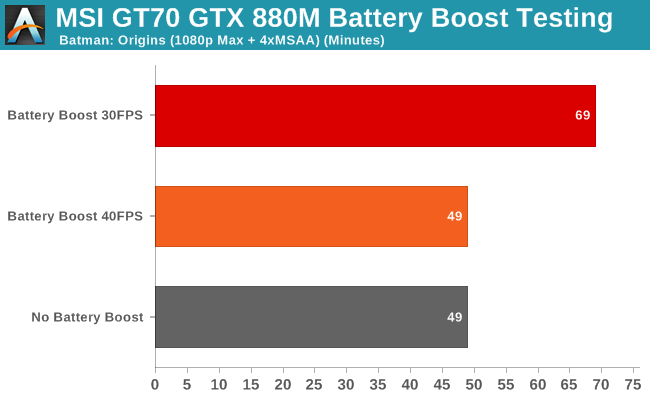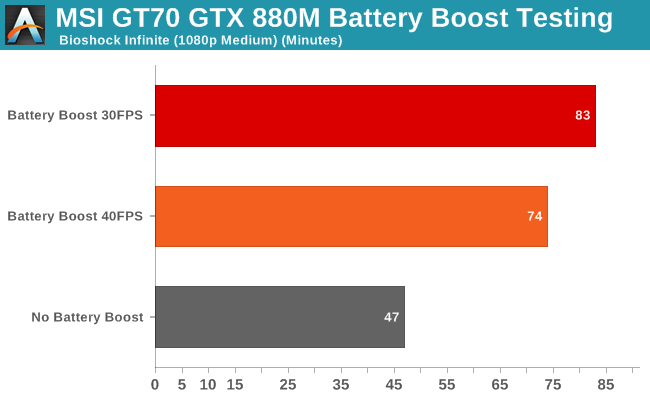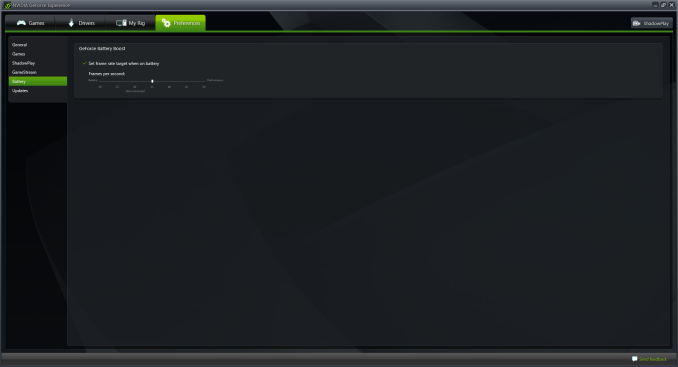MSI GT70 Review: GTX 880M Edition
by Jarred Walton on April 16, 2014 6:00 AM ESTMSI GT70 GTX 880M: Battery Boost
After the gaming potential, the next most interesting aspect of the GT70 – and the GTX 880M – is going to be NVIDIA’s new Battery Boost technology. Battery Boost is part of the GeForce Experience software package, and it’s currently only available with GTX 800M GPUs. It’s a single setting that you can either enable or disable, with a target frame rate slider ranging from 20 FPS to 50 FPS. Given this is a work in progress, you can expect changes to the feature over the coming months, but let’s just start with what we have right now.
We’ll need to spend additional time investigating the quality, performance, and battery life tradeoffs that are available, but for the time being we ran some tests with three games, choosing a specific quality setting for each and testing without Battery Boost and with Battery Boost using both 30FPS and 40FPS targets. We’ll also repeat our discussion of gaming performance on AC power as a reference point, and as you’ll see even without Battery Boost enabled, at least on the MSI GT70, there’s a rather large loss in performance that comes with the removal of AC power. The three games and settings we used are Batman: Origins at our “Enthusiast” settings (1080p, 4xMSAA, and everything else maxed out with the exception of PhysX, which is left off), Tomb Raider (1080p and “High” defaults), and Bioshock Infinite (1080p and “Medium” defaults).
There are many things we can look at with Battery Boost: average frame rates, minimum frame rates, battery life, GPU core/RAM clocks, and GPU utilization are all potentially interesting. Something else that came up during testing that’s also worth a short discussion: game/level load times. You wouldn’t think that would be much to talk about, but at least in our initial testing – and keep in mind that we’re using a notebook with pure HDD storage – we found level load times could be almost unbearable with Battery Boost set to 30FPS in some games. We’ve mentioned this to NVIDIA, and they were able to reproduce our longer load times, but the 5+ minute load times in Batman Origins were not something they could recreate; most of the other games I checked took 25-50% longer to load with Battery Boost at 30FPS compared to running off the battery without Battery Boost. This should be fixed in a future update, either to the drivers, or GeForce Experience, or both.
As for reporting the other figures, we’re going to hold off on that for a bit longer while we run additional testing. We’re working on a lengthier analysis of Battery Boost, and we’ll cover such things as minimum frame rates, average power use, etc. in a future article. For now, let’s just focus on the battery life as well as the average frame rates (though we won’t have graphs for the latter). We used the “Balanced” power profile with the display at 200 nits (70%) and timed how long it took before the system shut down. To keep things repeatable and consistent, we just loaded a save on each game and left it running, so there are no level loads (other than the initial startup of a game) or any “real” gameplay, but there is a constant load on the system during the testing.

Starting with Batman, if you focus solely on the percent increase in gaming battery life, Battery Boost looks pretty promising. In Batman: Origins, there’s a 41% increase in gaming time at the 30FPS target. Unfortunately, setting the target to 40FPS, there appears to be no change at all in battery life, likely because average frame rates even without Battery Boost are only 44FPS at the selected settings. As we’re using our Enthusiast settings, the average frame rate under AC power for our particular save is only 65FPS. Since Batman was the first game we tested (and one of the few games that clearly breaks 60FPS average at maximum quality settings on AC power), we decided to drop to slightly lower quality settings for the next two games.

Dropping the quality settings a bit, Tomb Raider at High detail shows an improvement in battery life both at the 30FPS and 40FPS targets, but not surprisingly the boost is larger with the lower frame rate. The increase in battery life is 48% at 30FPS compared to just 13% at 40FPS. Average frame rates without Battery Boost are 63.9, so despite NVIDIA’s claims to the contrary, it seems like most of the increase in battery life comes by capping the frame rate – in fact, the loss in average frame rate is greater than the increase in battery life (though obviously there are other factors at play). Frame rates on AC power for this particular scene average 88FPS.

Given that higher base frame rates appear to result in a larger improvement in battery life, for our third test we decided to drop down to medium quality in Bioshock Infinite. Here we see the largest increase in battery life of our testing: 77% additional battery life with a 30FPS target, and a still sizeable 57% increase with a 40FPS target. The non-Boost framerate is 63FPS, so again we see a very strong correlation between frame rate targeting and Battery Boost. Interestingly, however, at 40FPS we see a greater benefit compared to Tomb Raider, so at least we do have some evidence that there’s more than just frame rate targeting coming into play. AC frame rates at our test settings, incidentally, are 123FPS.
As noted, there are a lot of potential items to discuss with Battery Boost, and I’m not going to spend too much more time on the subject here. The technology does work, but the gains are going to be heavily influenced by your choice of game as well as graphics settings. My recommendation is to generally shoot for Medium to High detail at 1080p (at least on the GT70), as that still provides a decent quality level while allowing the GPU to rest a bit (i.e. average frame rates without Battery Boost will typically be north of 60FPS).
Besides the odd behavior with level/game load times taking longer with Battery Boost – sometimes substantially longer – there’s one other piece of information I need to quickly mention: minimum frame rates. With Battery Boost at 30FPS, the minimum frame rates can periodically dip well below 30FPS – sometimes even into the teens or single digits on some titles. This appears to be buggy behavior, as at 40FPS the minimum frame rates are often close to 40FPS, but right now there are at least a few games where using a 30FPS target will result in a rather poor gaming experience; targetting 35 or 40 FPS currently results in a much better experience.











61 Comments
View All Comments
Notmyusualid - Monday, April 28, 2014 - link
My M18x R2 laptop regularly hits the 200fps cap in Black Ops 2, all graphic options maxed out...And I'm sure as sh1t the 880M GTXs are faster than my 7970M's...
I'd almost kill for a 120fps display, like the M17x's have...
smitty123 - Thursday, April 17, 2014 - link
Good review but i gotta say this, i've just had to deal with MSI customer service for my laptop i bought 2 years ago, so its out of warranty.Msi customer service, what a joke. They wanted money $$ to tell me my machine was broken. i know it is and i know what is broken, i sent them the pictures, the screen cover broke where the hinges screw into it.
Money to tell me what i need fixing ? They think people are idiots.
They wanted 50$ to tell me i'll need a new plastic cover that would probably go for 250$, can you believe that ?
I replied asking them for an estimate, its been weeks and still no reply, no mention of how much $$ to actually fix it, just "give us 50$ to open a case file". What a joke.
Here you have a loyal customer who's bought their hardware for years and instead of actually being helpful they play this money grubbing game.
Not cool MSI !
You don't mess with customers that way. it's a surefire way to not get repeat business !
So i said screw that, i went with ebay. And after that i'm selling the laptop, getting rid of that pos.
it's a horrible noisy laptop, the GT70 aren't any better, the fan and heatsink need a complete overhaul and to be quiet. it's like they don't learn from their past versions. lol
i'm never buying msi again. Their customer service sucks plain and simple.
Henry H. - Friday, April 18, 2014 - link
Dear Customer,We are very sorry about this and believe there must have been a miscommunication regarding the diagnostic fee for the OOW RMA service. We do not charge this fee which is $49.00 upfront at all we do take CC info but there is no charge for the OOW RMA number to be released all you have to do is agree to the diagnostic agreement. The only time that the diagnostic fee is charged is if the repairs are declined after the laptop has come in and has been fully diagnosed and a complete repair quote is sent out to the customer. And if the customer agrees to the repairs then the $49.00 diagnostic fee is not charged at all only the repair charges apply the diagnostic fee is waived at that point. We do believe in providing the best customer service experience to all our customers and we are sorry that you feel this way. We hope that you would reconsider and let us provide this OOW RMA if needed. But again we take pride is providing all our customers with the best customer service experience so that that they are fully satisfied and happy. So please do contact us at USUsersupport@msi.com and we will follow up with you ASAP.
Thank you,
MSI SSD,
Communism - Thursday, April 17, 2014 - link
Anyone who's not mentally retarded buys a Clevo if they're a gamer anyways.Everything else is pure crap in comparison.
Bully303 - Friday, April 18, 2014 - link
Well educated comment there..noterple2 - Friday, April 18, 2014 - link
You also need to add "... buys a Clevo with an external keyboard.." I have yet to type on a clevo keyboard that had more structural integrity than a plate of overcooked noodles.sf101 - Tuesday, April 22, 2014 - link
I agree with some things the Reviewer says.I personally Own a GT70-2OC with the 770m gpu in it instead of the 780m. a few reasons i went that route .
Price over all on the 770m versions were much much lower by a large margine and the packages available were more flexible too.
I got my version for 1300$
I immediately bought a 64gb Adata SSD and installed it "voiding warranty" and enabled Cache mode which alleviated the 5400 rpm driver performance problems for cheap "50ish$"
Reviews also said the 770m used far less power then the 780m and by everyone's complaints about fan noise with the 780m and 880m i would have to agree as i can game on the 770m gpu without having to turn on the higher fan performance button and not experience any throttling.
so that said this laptop even when gaming seems to be fairly quiet when running overclocks on the gpu it does require the turbo fan mode to be on which i agree that is fairly loud.
As far as higher resolultions on a 17" screen? i dont know if that would be worth the extra cost to me personally any smaller and i think it would feel uncomfortable to read.. and the resolution seems fine for gaming on such a small screen at this resolution. also with these gpu's im not sure your going to maintain fps very well at 1440+ resolutions.
i also agree with the op that turning down some gfx in the name of heat / power use and noise may be a good option.
and i also agree that msi is retarded with their memory configurations. they dont seem to want to keep dual channel kits involved. their 8gb models come with a single stick of memory instead of 2x4gb am i missing something here? wouldn't 2x4gb in dual channel provide supurior performance and the notebook would also still have 2 more expansion memory slots available so its not like your hindering expansion by using up two slots in the name of performance considering you void warranty upgrading as it is.
Overall Ive had a really good experiance with this laptop from msi but as the reviewer said im not sure why they dont change a few cheap options in the name of performance.
7200rpm drives for instance in the units that come with just a HDD would be a good start.
and dual memory configurations that work not breaking them with either single stick or miss matched memory sticks "8gb +4gb??????".
dual fan cooling would really help with noise on the larger units but how about just unlocking the bios for us or letting us configure a fan profile that doesn't require just 100% speed or auto ?
So while i really like the laptop i own i feel it could be vastly improved if msi just used their noggins a bit.
I like the looks of the GS models alot more even though it uses a slightly lesser GPU then the flagships it should perform well enough for desktop replacement and mobile use.
danwat1234 - Tuesday, April 22, 2014 - link
MSI, PLEASE find a way to ship the GT60 and GT70 2OD and 2PE and other 780m/880m MSI laptops with 240W AC adapters because 180W is not enough. "NOS" is a joke, a crutch. Why does the laptop have to suck power from the battery when the GPU and CPU are fully utilized when a slightly larger AC adapter would stop this?Asus uses a 240w AC adapter for good reason in their G750 and MSI should as well. I thought MSI would probably have learned their lesson after the tomshardware review blasting NOS back in July of last year;; http://www.tomshardware.com/reviews/gt70-dragon-ed...
This is especially important if an Extreme CPU is in the laptop. Having that being fully utilized along with the GPU, NOS will engage and whatever you are trying to do cannot be done forever because the battery will eventually drain to 30%!
Ethos Evoss - Sunday, April 27, 2014 - link
Hate when manuf. making hdmi upside down it is tacky n horrible and + chrome hphone mic etc jakcs .. looks so cheap ..bleeeHappyHubris - Wednesday, April 30, 2014 - link
I recently purchased a GS60 Pro from MSI. It's not directly comparable (4.3lbs vs 8.6 lbs), but I am enjoying the general build quality and recommend the model to anyone who is looking for a slim and light gaming notebook.Pros:
-Solid build quality
-Excellent Keyboard
-Gorgeous *matte* screen
-1080P resolution saves expense and allows you to side-step app resolution scaling issues
-You're not paying for a super high-rez screen that has little utility on a laptop unit
-Slim and light
-Excellent performance
-Ships with a SSD + HDD; you can replace the HDD with another SSD without voiding the warranty
-I haven't noticed any thermal throttling so far (the bane of ultraportable gaming units)
-Numberpad for those of us who use them
Cons:
-Giant "GAMING EDITION" logo on the cover prevents me from using this laptop in client-facing environments, because MSI still hasn't figured out that gamers are also normal members of society. My biggest con.
-Battery life is less than stellar
-The underside of this laptop gets groin-searingly hot when gaming
-Screen bezel is plastic and feels flimsy
Feel free to toss me any questions you have. Isn't it crazy to think that "Desktop Replacement" gaming laptops were 8-10 lbs just 2-3 years ago?